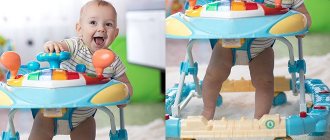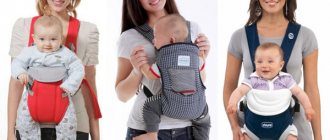Photo from the site: BabyBen.ru
From early childhood, our parents taught us that movement is life, and it is with the help of it that children learn about the world around them and get to know it better. Good health, as well as the proper development of a child, can be directly proportional to how actively and variedly he moves. For a child who does not yet know how to move independently, the optimal place to explore the world around him is his mother’s hands, so caring and safe, where it is so fun and pleasant to turn his head, reach out to everything, touch, look at, smell and even taste.
However, a baby that has grown considerably heavier becomes increasingly difficult for the mother to carry, and in order for him to learn to explore the world on his own, there are many beautiful, safe and very functional devices, for example, walkers, slings, jumpers, vibrating chairs, and so on. That is why the question arises when a child can be put in a walker, because every parent wants their child to always be healthy, and the device seems quite complicated for a tiny one.
When can a child be placed in a walker?
Experts are generally wary of the specific timing of the use of this or that device for children. Walkers were no exception. The main advice is that you should focus not on the manufacturers’ recommendations indicated on the packaging, but on the baby’s level of development and his capabilities.
Consider several important factors to determine at what month you should start using a walker.
- The baby must be six months old! This is the most important condition. The optimal age for starting use is seven to eight months. By this time, the muscular system is ready for the vertical position of the body.
- The baby must be able to get to his feet with the help of his parents or by holding onto a support (wall, furniture).
- The child sits calmly and does not fall over on his side. Therefore, his back muscles have already become stronger and will withstand sitting in the walker. The sitting age is also different for each baby.
- It is desirable that the child already knows how to crawl, thereby demonstrating readiness for new achievements. Early introduction to a walker can cause children to miss the crawling stage, which can lead to possible problems.
So, do not use this device if your baby is not yet 6-8 months old. And even at this age, approach the use of walkers with the utmost caution, focusing solely on your baby.
"Pros and cons"
Evgeniy Komarovsky considers walkers to be a device that has a very beneficial effect on the parents, and not on the baby. They are created, first of all, to make life much easier for mom. After all, it’s very convenient - I put the baby in a walker and went to cook, wash, iron, watch TV or work at the computer. The baby will not go anywhere from them, will not fall, will not stumble upon a sharp corner.
However, quite often parents complain that the child managed to fall out of the walker. This does not happen on its own, but mainly if the mother has not taken safety measures. A walker with wheels can tip over if it hits steps, if it hits hard, large single objects that can get caught in the wheel, or if the child is not securely secured in the walker.
Modern walkers have bright colors, almost all models are equipped with a play area with attached toys, and there are musical walkers.
Therefore, the child, by and large, is not against such a pastime, because he is more interested in a walker than in a crib. Supporters and admirers of devices claim that they carry a vital developmental function. This statement cannot be considered true, since there is no proven benefit from keeping a baby in a frame on wheels. Sellers of walkers are unable to prove their beneficial effects, no matter how hard they try.
But there are well-founded opinions of doctors who claim that walkers are not only harmful to the child, but also dangerous. Evgeny Komarovsky argues that the decision whether to use a walker should be made only by parents, and no one else. He doesn’t think that an hour spent in a walker is dangerous for the baby’s health, but a few hours is already an alarming signal. Everything needs moderation, and in relation to verticalizing devices, which include walkers, this statement is doubly true.
Positive aspects
When purchasing a walker, mothers believe that this will help their baby learn to walk faster, although this is a mistaken opinion. The positive aspects of using the device are as follows:
- The design allows you to protect your little one from falls while walking, bruises and collisions with furniture.
- While mom is busy with housework, the baby, who is in a walker, will not be able to reach dangerous objects.
Baby is busy
- Additions placed on the tabletop will occupy the baby’s leisure time, contributing to his mental development.
Walkers are a good alternative to a playpen. The ability to move around the room gives your child more freedom while still providing safety. Such activity of the baby has a positive effect on the development of the whole organism.
Negative aspects
Having learned to use a walker, the toddler loses the incentive to move independently, which slightly slows down the stages of development. If a mother starts putting her child on a mobile device ahead of time, without taking into account the pediatrician’s warnings, such an experience will give a negative result.
Note! A vertical load on a fragile spine will lead to poor posture, the development of diseases of the musculoskeletal system, and possibly disability.
If the baby, while in a walker, is not able to rest his entire foot on the floor, but only touches it with his toes, he will subsequently develop problems with the hip joints, and possibly flat feet.
Flat feet as a result of the influence of walkers
The toddler not only begins to walk independently later than his peers, but also does not know how to maintain balance, so without a walker he often falls.
What is the danger?
Nature has decreed that a child go through several stages in its development, which is clearly confirmed by the main stages of evolution. First, the baby lies down, then masters turning over, then begins to try to crawl, sit, and only after that - walk. This sequence is important for further normal development. An insufficiently strong spine does not allow the child to sit up on his own, and weak muscles of the back, abdomen, and lateral muscles do not allow the baby to confidently crawl and stand up.
The child must go through all stages on his own, says Evgeniy Komarovsky. He will sit down when his back is ready for it, and will walk when his spine and muscular skeleton are stronger. If parents begin to force things, forcing the child to sit and stand before the allotted time, then the vertical load on the spinal column, which is weak from birth, will increase significantly. This is fraught not only with poor posture in the future, but also with more serious consequences that can even lead to disability.
Early verticalization is a sure path to diseases of the spine and musculoskeletal system.
From this point of view, the use of walkers poses a certain danger for children who do not yet know how to sit or crawl on their own. Komarovsky strongly recommends against using such devices for children under 9 months of age at all.
Further, depending on the child’s skills and development, the walker can be used for half an hour to forty minutes a day. But the baby should not be in them all the time while he is not sleeping, because the baby is not yet able to understand his feelings and inform his parents that his back is tired. And the harm of vertical load is relevant for children aged 10 months, and even one year.
Psychological aspects
Dr. Komarovsky believes that such devices are more intended for mothers than for their little ones. A woman tries to put her baby in a walker not so much in order to teach him to move, but in order to distract the child from herself and get the opportunity to do other things or get some rest.
If the little one is attracted to the device, then he perceives being in the walker as a game. The kid likes not only the device of the model, but also the ability to quickly move from one corner of the room to the opposite.
Having become accustomed to the device, the baby will very quickly try to expand the space, trying to get into the next room. Here, “force majeure” circumstances may arise (the wheel gets caught on an obstacle, or the walker gets stuck in the doorway), causing the baby to get nervous and cry.
Additional Information. Children learning to walk with the help of the described device, finding themselves without it in an open space, feel insecure and often panic.
When are walkers contraindicated?
Neurologists and pediatricians categorically prohibit the use of walkers for children under 6 months, babies with poorly developed sitting skills and the following pathologies:
- rickets;
- dysplasia;
- diseases of the musculoskeletal system;
- strabismus;
- Cerebral palsy. Children with such lesions need special restraints: rear-supporting for pathologies of mild severity, forward-supporting to combat tiptoeing, simulators for holding the torso in an upright position.
- heart disease;
- mental and physical development delays;
- increased or decreased muscle tone;
- There are diaper rashes, inflammations on the lower body, butt.
Important! There is no need to insist on rolling around the apartment in a walker if the baby is tired, afraid of toys, or sick.
Video: walkers PROS and CONS
What Doctor Komarovsky says
The popular TV doctor, whom many mothers trust in matters of raising a child, does not advise artificially accelerating child development. Before standing on its feet, the baby must go through the stage of rolling over, crawling and sitting. This is an ideal “evolution” that can guarantee optimal development of the spinal column and muscle structures.
In turn, the use of walkers is fraught with the formation of incorrect posture and the occurrence of various diseases of the musculoskeletal system. For example, deformation of the feet and flat feet cannot be ruled out. This occurs due to excessive stress on the spinal column, knees and pelvic joints.
If you still decide to use a walker, then Komarovsky recommends starting at 9 months of age. You cannot place a child in this device for more than a quarter of an hour a day. These rules will allow you to avoid numerous problems and get only benefits from this pastime.
Gender issue
Moms are also interested in how many months they can put their boys in walkers. There is an opinion that the use of this device negatively affects the condition of the reproductive system of the future man. After all, the seat and straps can put pressure on the groin area and cause diaper rash.
Doctors do not share these concerns and recommend using baby walkers from the recommended age of 6-8 months. But at the same time, it is important not to leave the boy in the structure for more than forty minutes a day. If the child sits independently without support and likes to sit upright, then you can purchase a walker.
When putting a girl in a walker, the same rules apply as in the case of boys. That is, the baby must be older than six months and have the skill of taking a sitting position. At the same time, it should be remembered that girls are more susceptible to pelvic dysplasia. So you shouldn’t get carried away with this device.
Contraindications to the use of walkers
Experts strongly recommend not to use this device if your child:
- there is high or low muscle tone in the legs (the danger is that children move on tiptoes);
- the skin is damaged, or there are diaper rashes in areas of contact with structural elements;
- symptoms of rickets were detected;
- there are disorders of the musculoskeletal system;
- Fear of walkers is expressed (the baby cries if his mother tries to sit him down).
As you can see, before purchasing, you should carefully monitor your child, and even better, talk with your treating pediatrician.
The benefits of walkers - the main advantages
Any busy mother will confidently name the main advantage of this device - free time, which means you can do household chores or just relax while the baby practices in the walker. How is this simulator useful for children?
- The child is interested in the world around him, which opens up for him from a new, vertical side. It is not surprising that the baby receives positive emotions, which has a positive effect on its development.
- The baby gets a new opportunity - free movement, exploration of nearby objects, bright toys and new space.
- Physical mobility increases and the variety of movements increases. All this leads to increased formation of neural connections in the PD cortex.
- Modern walkers are a real exercise machine, equipped with the latest technology. The child will be attracted to rattles, various small balls and rings, which develop gross and fine motor skills.
- When moving in the device, children will not be able to reach unwanted and dangerous places: sockets, burners and sharp and glass objects.
The influence of walkers on baby development
The baby must be physically developed to form his psyche. All doctors are sure that the crawling period is the most important stage in the development of the baby. Therefore, he needs space so that he can crawl and develop his motor reflexes.
The effect of walkers on a child
Walkers give the baby relative freedom of action, allowing him to explore the world and objects around him. However, they affect the child’s mental and emotional development delay. Such children begin to walk with a delay of 2-3 weeks. Children do not feel danger and fear, but at the same time they seek the support of their parents, as they experience unreasonable panic.
According to pediatricians, it is better to purchase a playpen in which the baby can not limit physical activity.
Important! Don't put your baby in a walker too early. Its development must be timely so that posture is not disturbed.
Harm from walkers - main disadvantages
However, numerous and fierce disputes do not arise out of nowhere. Experts and experienced mothers make a number of serious accusations against this simulator.
- The baby does not need to hold himself upright on his legs. And this significantly slows down the formation of motor skills, which delays the time for independent walking.
- Children do not place their entire foot on their feet, but push off with their toes. A peculiar “ballerina” gait is formed, that is, walking on tiptoe.
- The constant straight position of the body, which is unusual at this age, puts a serious load on the spinal column, the position of the joints of the hip girdle, and the development of the muscles of the lower extremities.
- The most important stage - crawling - almost completely disappears from early childhood. And the benefits of moving on all fours are difficult to overestimate - the muscular frame is strengthened, coordination and consistency of movements are improved. The prerequisites for walking are created.
- The use of walkers negatively affects the formation of the cerebellum, which monitors the functioning of the vestibular apparatus. The baby, constantly being in the simulator, gets used to the fact that it is not necessary to maintain balance, since the walker supports the baby. This is why independent walking will turn out to be uncertain.
- The baby does not learn to fall correctly, and this is extremely important for safe development. When falling over from a short height, children learn to group muscles and thereby protect important organs. Constantly being in a walker does not contribute to the development of a sense of self-preservation.
- It is common knowledge that children learn about the world around them through touch. They pick up, touch, feel that an object is hot, cold, soft, hard, heavy, etc. A baby in a walker is deprived of the ability to grab something, which means he will not be able to reach dangerous things. And at the same time, he will not get to toys and important items.
- Take it as an axiom - this device is dangerous. The child moves quite quickly, which means that at speed he can run into jambs or hit the wall. Sometimes children trip on the carpet and fall over, which can result in serious injury.
Positive effects on health
Knowing when to put your child in a walker can help you focus on the benefits of using the walker. They will help the child develop physically and psycho-emotionally:
Benefits of walkers for a child
- cause joy and good mood;
- strengthen the muscles of the back and spine, preparing the baby for independent walking in the future;
- strengthen the leg muscles, which will help you move further easily;
- train the vestibular apparatus;
- help explore new objects and surfaces;
- develop tactile sensations;
- help to correctly perceive the surrounding world;
- increase physical activity;
- develop thinking.
How to choose the right walker
If you are still convinced of the usefulness of this design (despite the predominance of negative aspects), carefully read the tips below. Choose carefully, since a low-quality product, in addition to being inconvenient to use, can harm your baby.
Where to buy
Never purchase walkers from online stores. Of course, such purchases are convenient and significantly save time for young mothers. However, children’s health is at stake, so make sure for yourself that the device is safe – check for strength and compliance with the stated characteristics.
Basic selection options
- Walker base. Choose models with an extended base so that the baby cannot roll over with the exercise machine, even if he leans over the edge while reaching for an interesting thing.
- Wheels. The wheels must be small to make the structure stable and maneuverable. Rubber wheels are preferable to plastic ones as they allow the walker to move smoothly. Make sure the wheels turn in all directions.
- Sitting. For the comfort of children, it is important that the seat is deep enough. Then the baby will not fall out of it. The material from which the seat is made must be both soft (for comfort) and dense so as not to sag.
- Back. Try to choose models equipped with a backrest. It should be high enough and rigid enough to support the child's back without allowing the child to fall back. It would be good if the backrest could be removed and washed, since some children eat in walkers (although this should not be done).
- Height. Make sure that the baby does not bend his legs too much at the knees and, conversely, does not walk on his toes like a ballerina. To do this, you need to purchase a walker that can be adjusted in height by raising and lowering the seat.
- Compactness. This characteristic of the product is important if the room itself is small and the doorways are very narrow. Try to purchase folding models, which are less bulky and easier to move from place to place.
- Weight. Another important component of a safe walker. Similar information is in the description of each model. Give preference to a product designed for a child’s weight of 15-20 kg if your family has a large child. For a thin baby, walkers are suitable, the instructions for which indicate 10-15 kg.
- Additional options. Modern simulators amaze with a variety of additional functions. Some models are equipped with game and music panels, tabletops for eating. It all depends on the children’s and parents’ preferences and the financial capabilities of the family.
Types of devices
There is a large selection of walkers on the market today.
They are divided into:
• classic – help the baby move independently;
• rocking chairs – used for movement and rocking;
• wheelchairs - for babies who can walk, the device is similar to a stroller with a handle;
• jumpers - looks like a backpack in which the child is secured, helps teach the baby to stand and jump, develops a sense of support and the vestibular apparatus.
It is recommended to buy classic walkers and rocking devices from 7-8 months of age.
Wheelchair structures are used for children 1 year and older.
Jumpers should be used no earlier than 8 months of age, since jumping increases the load on the spine even more.
The products are made of lightweight but durable material.
It is advisable to choose classic models with a restrictive lower ring. This is to prevent injuries when hitting objects if the baby accelerates too much.
Walkers make life easier for parents and allow them to free up time for household chores.
Despite the convenience, it is necessary to use the product no more than 1 hour per day, and preferably up to 40 minutes.
This will prevent the development of pathologies of the musculoskeletal system in infants.
Doctors recommend using the structures no earlier than 7-8 months of age.
If all operating rules are followed, walkers do not cause harm to health.
Walkers for boys and girls
Everyone knows that the structure of girls and boys is different and they also develop differently. So how to use walkers for children correctly and at what age should a boy or girl be put in them?
Our girls develop earlier than boys, and there is also an opinion that they begin to walk a little earlier. But this does not mean that they need to be put in a walker at 5 months.
The optimal age for a walker is 7 or 8 months. It’s just that in the case of girls, you need to pay special attention to her physical health and keep track of the following points:
- If the child is overweight, you should go to a massage therapist and prepare your legs to start walking;
- Girls are more likely to develop dysplasia of the hip joints, so mothers should pay special attention to properly familiarizing themselves with walkers. The fact is that, through ignorance, you can aggravate the development of this disease.
Now we know when we can put girls in walkers, let’s move on to our boys:
- In the case of a boy, the mother should pay special attention to the child’s comfort in the walker, so as not to squeeze the genitals and prevent overheating. When can boys be put in walkers? As in the case of girls, the optimal option is 7-8 months, taking into account his physical activity and stage of development.
For both boys and girls, 3-5 minutes of being in a walker is enough to start with; in the future, you can increase the time to 40-50 minutes per day.
Classic model
Every company that produces walkers has classic models in its assortment. The basic design consists of several parts:
- wheelbase;
- plastic base;
- deep seat made of durable fabric.
Classic models of walkers are complemented by toys built into the tabletop. For high-quality products, the height is smoothly adjustable, stability and ease of movement are ensured by a sufficient number of wheels, 8 pieces guarantee maximum comfort and mobility.
Walkers
The use of wheelchairs is approved by all pediatricians. These models are intended for children aged about one year. They help the child master walking skills. The device is a stable cart equipped with a handle, which the baby holds on to while moving. Advantages of wheelchairs:
- the baby rests on the floor with the entire area of the foot;
- When moving, the child has to independently control his balance.
Most of the models can be classified as high-quality educational toys. Walkers are equipped with a variety of play blocks.
Transformable walkers
Multifunctional device. With its help, the child is offered different options for activities. In addition to the main purpose of walking, transformable walkers have other uses. They can perform the following functions:
- jumpers;
- tolokar;
- feeding table;
- gaming mini-complex.
These are not budget models, they are not suitable for small apartments, they are large in size and weight.
Rein
An alternative option for walking with a baby under 1.5 years old. They will be useful for parents when the child begins to walk down the street and takes his first steps hand in hand with his dad.
The reins are attached to the baby’s body and act as a safety net so that the little walker cannot hit the ground.
Rating of the best
Parents and babies will love the DJ Baby Walker, a stable model of classic walkers from Chicco. It is made of durable plastic, its safety margin is enough for several generations of kids. The seat is soft and equipped with an orthopedic backrest. The wheels are durable, have good maneuverability, and can easily handle small obstacles such as thresholds or carpets. The device has 3 height levels, a development panel, brakes, a removable table, and weighs about 5 kg.
The Mario walker from Happy Baby is equipped with a long handle with which parents can help the baby move around the room. Good mobility of the device is provided by 8 silicone wheels.
The seat is removable and can be washed by hand or in a machine. The model is designed for children from 6 months weighing no more than 11 kg. There are toys for the development of fine motor skills; for a child who is a music lover, there is a selection of 11 melodies. The Babyhit company produces a reliable, maneuverable model of baby walkers Balance. It is designed for babies weighing up to 12 kg. There are 3 seat heights, 8 wheels, removable seat, game panel. The weight of the device is 4 kg, it folds easily.
Baby walkers - safety precautions
Of course, finally, it is necessary to say a few important notes regarding the safe use of this device.
To avoid problems with your child's health:
- Make sure that children's feet are firmly planted on a hard surface;
- pre-adjust the simulator according to the child’s height and put on shoes with thick soles for the baby;
- keep away from stairs, uneven surfaces and other unsafe places;
- never leave him alone in a walker;
- the duration of his stay in the simulator should not exceed one hour per day;
- Be sure to consult with a specialist to find out whether the walker is right for your child.
Negative health effects
There are several points that can negatively affect the baby's health. Baby walkers have different effects on a child’s health depending on his individual characteristics:
- lack of motivation to move independently;
- the ankle joint may not form correctly;
- no variety in physical activity;
- the spine is too loaded;
- imbalance of balance;
- the risk of injury increases.
In any case, the choice remains with the parents. Choosing the right walker and following the operating rules will help your baby develop in all directions.











